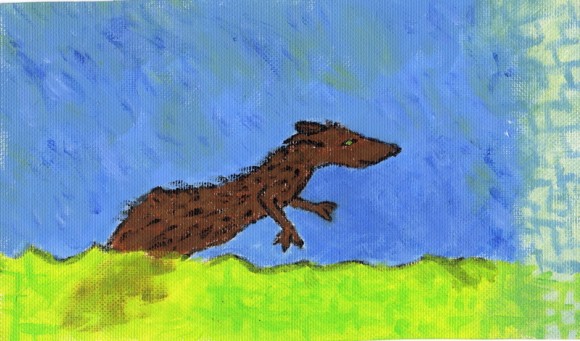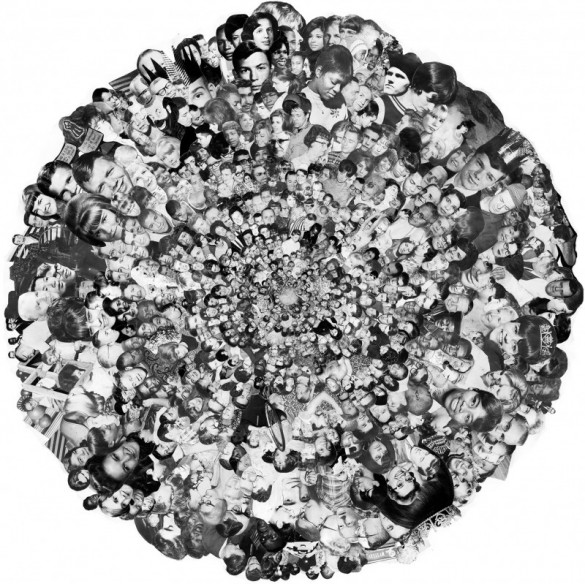
Writing down dreams is a great practice for increasing dream recall, but words are not the only way to work with dreams. We know this intuitively, because seldom does a “dream report” convey the full expression of a dream, no matter how detailed or how many adverbs we use.
Enter Dream Art.
Dreaming is largely imagistic, so it makes sense that visual art is a natural way of honoring a dream. Now, there are a million ways to incorporate dreams into artwork, but I am going to present a method that actually can deepen your understanding of a dream. A caveat: this method works better with “big dreams” which tend to be more emotional and memorable.
The key to making dream art is to centrally locate the core image or set of images you want to work with, and then choose a medium that you enjoy. This could include painting and drawing and sculpture, of course. But if you don’t enjoy painting, consider collage. All you need is a pair of scissors, a stack of magazines and some glue and you are ready to go. If you are a scrapbooker, then you have been preparing for dream art without even knowing it. Scrapbooking adds real world details to your own images and drawings, and can incorporate texture as well as visual information. For a truly multi-modal dream expression, bust out some scratch and sniff stickers.
The Contemporary Theory of Dreaming
The focus on a central dream image is what makes dream art an extremely effective way of processing the significance of a dream. It’s a great way to introduce one of the top theories of dream formation too: the Contemporary Theory of Dreaming. Suggested by psychiatrist and nightmare researcher Ernest Hartmann, this theory posits that big dreams have a “central image” that holds the key to the dream’s emotional meaning.
Hartmann suggests that one of dreaming’s psychological functions may be to contextualize strong emotions that are related to impactful events and memories. By cross-referencing an emotion with the visual systems in the brain, the dream creates a web of associations to make sense of it. In this way, we create visual-emotional “narratives” that help us predict, cope with, and respond appropriately to the world.
Finding the Central Image of a Dream
How do you know what the central image is? It’s the image, symbol, or plot point in your dream that has more vivid color and bizarreness. In a nutshell, the central image is the thesis statement of the dream; it’s the image you wake up with and that keeps coming back up long after other details have fallen away.
Working with the central image is an easy starting place for dream work, whether you are working on your dreams alone, with a group, or with a therapist. Hartmann (2008) suggests that the Central Image is truly the Royal Road to the unconscious, which :
“can often lead very quickly to an important underlying emotion or concern. Sometimes this leads to a totally obvious emotion or concern, that hardly needs mentioning. But sometimes an emotion or concern emerges that was not quite conscious before, and can be worked with.”
Case Study: the Dream Art of Chase Markovich

Here is an example of a dream from artist Chase Markovich that became the inspiration for the dream collage, seen above. As you read the dream report, note how powerfully the central image made itself known!
Walking down the street with a girl, we come upon a cathedral of large dark bricks, on the steps of which is an older looking gentleman probably in his 50’s, singing hymns. He is dressed very sharp, in a vest, possible pocket watch, a nice jacket, in all white, as well. I think to give him some change. He offers to show me pictures of his artwork in exchange. He leads me to my nightstand which is actually in my room now, but in the dream is up against one of the walls of the cathedral. He opens the drawer, takes out polaroids and hands them to me. I look at the polaroids and see pictures of my friends, and pictures of artworks I know are mine but i haven’t made yet. I turn to him and say “these are mine. How did you get these?” He ignores me because he is talking to his daughter on a red cellphone. i think maybe i had given them to him. I look at the picture again unable to fathom how he has photographs of artwork I will make in the future, then I see the mandala, it explodes from the Polaroid and engulfs me, as it spins radiating blue and orange light I think I am seeing all the people I have ever loved, or ever will love. I wake up shortly afterwards.
When I met Markovich, he told me he knew he had to honor this dream with art, but of all the polaroids he saw in the dream, he could only remember the mandala — the one image that literally “explodes” and hastens his awakening from the dream. He spent the next four months cutting out photos and making this mandala.
The result? He told me that the process was rewarding because it promoted an every-day meditation on gratitude for all the people in his life, leading him to communicate to his family how much he cares for them, as well as renew several important relationships.
To see more of Chase Markovich’s art work, here is the link to his online gallery.
Adding Art to your Dream Journal
I also recommend incorporating art in your dream journal whenever possible. It’s satisfying and makes reading your dreams later a real pleasure. Carl Jung often painted his dream images – in fact the infamous “Red Book,” Jung’s private journal, is now available. (for the reproductions of his artwork that have never been seen before, you’ll want the big version). A more modern example: a friend of mine blogs her dreams and uses found imagery to illustrate the feeling of the narrative. It’s obvious she has a lot of fun with this process and the results are often hilarious.
We are just scratching the surface here, and of course there is no “right way” to do dream art. So how do you make art from your dreams? Leave a comment and let us know!
The next article in this series is explores dreams and the human body.
Cited: Hartmann, E. (2008). The central image makes “big” dreams big: the central image as the emotional heart of the dream. Dreaming 18(1); March 2008, pp. 44-57.
I really enjoyed this article, Ryan. Thanks for the link to your friend’s blog!
Check out Kathryn Taylor’s artwork and dream memories.
http://web.mac.com/KathrynTaylor2/Artwoman/Creative_Process.html
hi, ryan. great article. glad to see it and glad to be a part of it.
thanks,
Chase